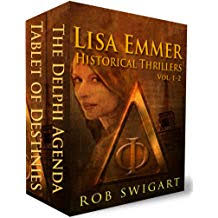“The Delphi Agenda” by Rob Swigart
On the Amazon page for The Delphi Agenda, Rob Swigart’s novel is described as “An action-packed unraveling of the secrets of ancient history mixed in with a chilling conspiracy that brings to mind Dan Brown’s bestseller INFERNO.”
To my mind this is somewhat true, but I would mention important differences. One, compared to The Delphi Agenda, Brown’s Inferno could be characterized as an outline of a story. Swigart explores many more nuances of the centuries-old conflict between the Catholic church and its wayward Christian detractors. Unfortunately for people who lived in France and Spain in the 12th century and beyond, the Vatican chose to crush dissent with murder, which history refers to as the Medieval Inquisition. It was just one of many of the Church’s Inquisitions. This lack of adherence to Catholic doctrine was called heresy.

Herein lies the core of Swigart’s The Delphi Agenda moved forward to the present day. A few devouts still seek to murder the dissenters, who really have no particular quarrel with the Catholic church but simply wish to pursue their own intellectual and spiritual interests, symbolically represented by the ancient Greek Oracle at Delphi. The so-called devouts hope to destroy the one remaining piece of evidence that remains, the Founding Document. The dissenters, who pursue it as well, do so without rancor but rather to preserve this important papyrus record that dates back several millennia.
Swigart digs deep into these archaeological, papyrological, cracks and crevices, developing a deeper interest in the subject than a simple clash of good guys and bad guys. The novel, being fiction of course, satisfyingly reads as if it has been assiduously researched by the author, which of course it was. By comparison, this type of detail in a Brown novel is like trying to take in the scenery passing by while riding the SNCF bullet train.

I could see and feel the scenes on the rues of Paris, but I was also caught up in feelings and memories of medieval Europe. A few years ago my wife and I toured France, mostly along the northern border with the English Channel through the régions of Brittany, Normandy and Hauts-de-France. We visited Mont-Saint-Michel, a castle/monastery/fortress (at one point it was, of all things, a prison!) that dates back to the 8th century. It rests upon an island near the edge of the Channel in such a way that when the tide is in, you need a boat to reach it. Once there, it’s a very perpendicular city with cobblestone footpaths winding past tiny shops as you climb up the Mont to eventually reach the Saint-Michel.
I was struck by its history and the fact that it has existed for 13 centuries. In its bookstore I found a copy of Ken Follett’s The Pillars of the Earth, a 1,000-page historical novel concerned with building an early Gothic cathedral in 12th century England. I had loved reading that book, and it drew me into this moment that was all about being in Mont-Saint-Michel and immersed in this history. I bought another copy of Pillars, which I keep preserved in Saran Wrap on my bookshelf.
I felt similarly immersed in The Delphi Agenda. I felt I got to know Lisa Emmer and the other characters and developed genuine feelings – positive, negative and sympathetic – for all of them, to the point that I want to read the second Lisa novel in the series, Tablet of Destiny. I will, and I hope I’ll be swept up and away again in Rob Swigart’s story.




